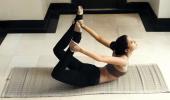Yoga is an ancient approach of staying fit that can help you with a variety of health issues.
It can be a natural and safe method to control hypertension, often called the 'silent killer'.
Sedentary lifestyle, poor and low nutrition diet, obesity, smoking, constant stress, and other factors can all contribute to high blood pressure.
How can yoga help someone with hypertension?
Yoga positions require you to breathe in a specific manner, which can help you control your blood pressure and reduce stress levels in your body.
Yoga asanas require you to breathe deeply and consciously while synchronising your body motions.
Stress and hypertension are caused by a lack of sleep, and yoga can assist to regulate sleep habits and patterns.
Yoga practice combined with a healthy, nutritious diet will help you maintain body weight and battle obesity.
Yoga infuses the body and psyche with positive energy making you feel better about yourself.
Here are 10 yoga poses to fight hypertension. Practice them daily for maximum benefit.
1. Setu Bandhasana (Bridge Pose)

How to do it
- Lying on your back, bend both knees and place your feet flat on the floor, hip-width apart.
- Bring your arms alongside the body with your palms facing downwards.
- Inhale, pressing the feet into the floor and lifting the hips up.
- Bring your hands onto the lower back for support if you wish.
- Stay here for 10 seconds and continue to breathe.
- Exhale and come down.
- Start by holding this asana for ten seconds.
- Come down, rest for a few breaths, and then repeat the pose.
2. Vajrasana (Diamond Pose)

How to do it
- Sit with your legs under your body.
- Your spine should be straight with knees close to each other.
- Breathe in deeply, for a count of 1, 2, 3, 4, 5, 6, 7, 8 and then breathe out completely for a count of 1, 2, 3, 4, 5, 6, 7, 8. While you breathe, focus on the energy point between your forehead.
3. Balasana (Child's Pose)

How to do it
- Begin in a kneeling pose, sitting on your heels.
- Inhale and bring your forehead to the ground.
- Your arms should be placed on either side of your body. Breathe deeply.
- Bringing your right arm underneath your left shoulder, look to your right fingers.
- Repeat on the other side.
4. Viparita Karani (Legs up in the Air)

How to do it
- Sit up straight in a comfortable and relaxed posture, facing the wall.
- Shifting your pelvis as close to the wall as possible, place the legs up against the wall.
- Inhale and exhale as you relax deeper into the posture.
5. Adho Mukha Svanasana (Downward Dog Pose)
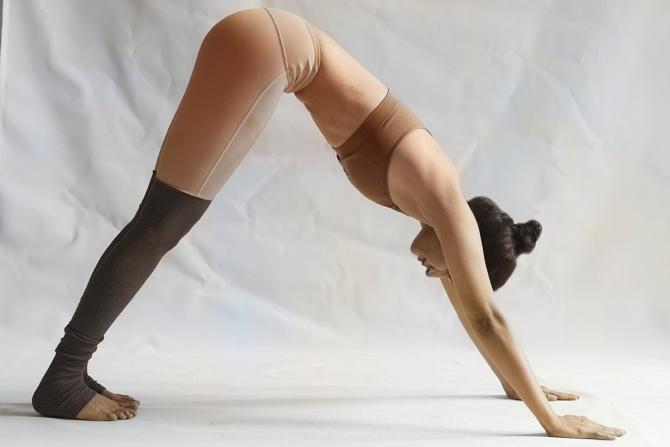
How to do it
- Come on your hands and knees. Keep your knees directly below the hips and your hands a little in front of your shoulders.
- Lift your knees from the floor, making your legs straight and pushing your hips upwards and back. Keep your arms straight with your palms flat on the ground. Your head should be between your arms.
- Your body should form an upside-down V shape.
- Breathe deeply and hold this pose for a few seconds and then relax.
6. Baddha Konasana (Butterfly Pose)

How to do it
- Sit up with your legs extended in front of you.
- Bending both your knees, bring the soles of both feet together and grab the big toes.
- Keep your back straight, flap the thighs up and down to mimic a butterfly's wings.
- As you inhale and exhale, you should be able to pull your feet closer toward your body and relax deeper into the pose.
7. Janu Sirsasana (Head to Knee Pose)
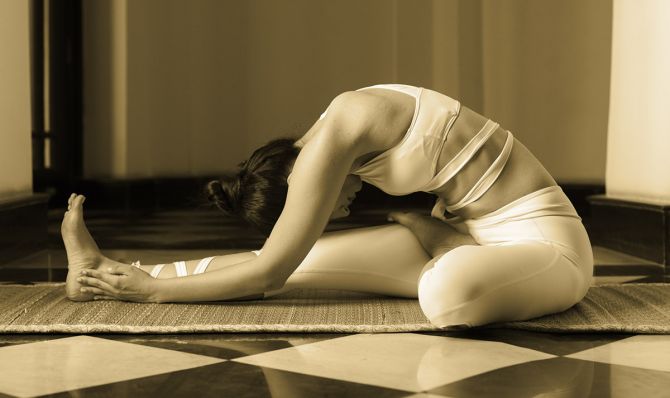
How to do it
- Sit on the floor with your right leg extended forward.
- Bend your left knee out to the side. Make sure your left foot is pressing into the right inner thigh.
- Inhale deeply and raise your arms above.
- As you exhale, bend at your hips, folding forward towards your right leg.
- Hold your outstretched right foot with your hands, stretching forwards.
- Hold this pose for a few seconds and then relax.
- Repeat with left leg.
8. Halasana (Plow Pose)
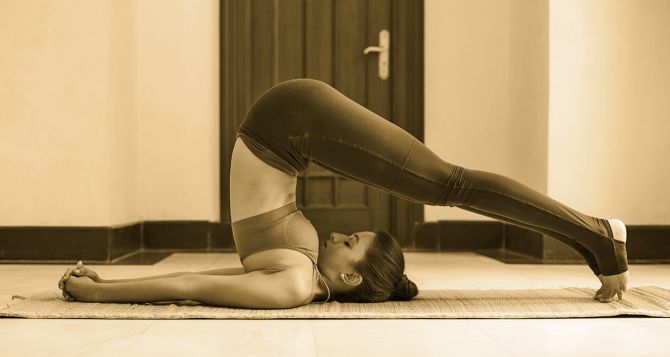
How to do it
- Lie on your back with your hands to your side.
- Lift your legs until they are perpendicular to the floor.
- Bend your elbows and place your palms under your waist.
- With your hands, push your legs over your head till they are at a 180° angle. Try to touch your toes to the floor.
- Hold this position for a few seconds and then relax.
9. Bhujangasana (Cobra Pose)
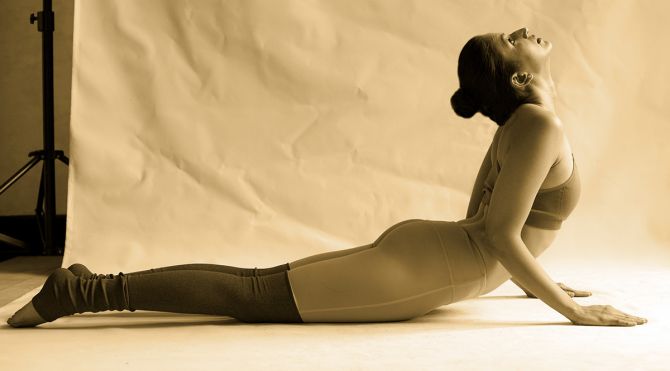
How to do it
- Lie flat on your stomach, face down.
- Put your hands beside your rib cage with palms flat on the ground.
- Press your palms into the floor, inhaling deeply as you lift your upper body (that is, your head, neck, shoulders and upper chest) off the ground.
- Keep your breathing normal and steady.
- Hold this position for 30 seconds.
10. Shavasana (Corpse Pose)

How to do it
- Lie down on your back with legs apart. Keep palms a little away from your body and facing upwards. Make sure you are comfortable.
- Close your eyes.
- Focus on your body and breathing as you relax. Breathe deeply and slowly.
- Hold this position for 10 minutes.
If you have had high blood pressure for a long time, you should not ignore it and should see a doctor.
Yoga is incredibly useful to your physical and mental well-being. If you are on blood pressure medication, please consult your doctor first before incorporating yoga into your practice.
Disclaimer: All content and media herein is written and published online for informational purposes only. It is not a substitute for professional medical advice. It should not be relied on as your only source for advice.
Please always seek the guidance of your doctor or a qualified health professional with any questions you may have regarding your health or a medical condition. Do not ever disregard the advice of a medical professional, or delay in seeking it because of something you have read herein.
If you believe you may have a medical or mental health emergency, please call your doctor, go to the nearest hospital, or call emergency services or emergency helplines immediately. If you choose to rely on any information provided herein, you do so solely at your own risk.
Opinions expressed herein cannot necessarily provide advice to fit the exact specifics of the issues of the person requesting advice.




